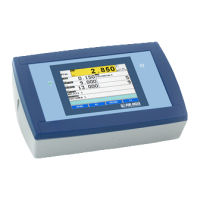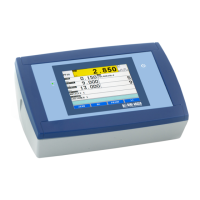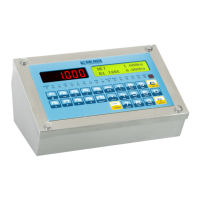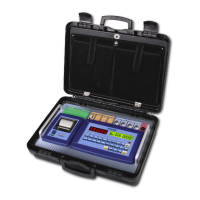Do you have a question about the Dini Argeo 3590EGT8 and is the answer not in the manual?
Overview of the manual's aim and the instrument's capabilities.
Crucial warnings regarding user safety, instrument modification, and power disconnection.
Guidelines for charging and maintaining the rechargeable battery.
Instructions on handling, cleaning, and installing the instrument safely.
Lists optional internal and external modules to enhance interfacing possibilities.
Explains symbols and texts used to draw user attention in the manual.
Details power requirements and connection methods for different indicator models.
Step-by-step guide for turning on the instrument and initial display messages.
Procedures for correctly switching off or restarting the instrument.
Describes how to activate a printer in energy-saving mode for systems with battery power.
Explains the primary functions of key buttons on the instrument's front panel.
Details functions for C/DEL, TARE/ZERO, Fn/ENTER, and 2nd F keys.
Explains how to access secondary functions by combining the 2ndF key with other keys.
Guide on inputting descriptions, numbers, and special characters using the keypad.
Instructions on how to lock/unlock the keyboard to prevent accidental key presses.
How to access the help menu to view key functions and their status.
Explains how to connect and use a PC keyboard to emulate indicator functions.
Lists and describes available remote control types and their basic functions.
Details the functions of the 19-key infrared remote control.
Explains the programming and usage of the 6-key radio remote control.
Allows increasing weight digit size for better readability on specific models.
Explains the meaning of LED indicators and LCD display symbols.
Details meanings of various LED indicators like POWER, NET, TARE, and units.
How the indicator displays battery charge status (charging, partial, discharged).
Visual representation of battery recharge status and notes on usage.
How measurement data is presented on the display for 3590E and CPWE/CPWET.
How to customize the LCD display using DiniTools software.
Examples of data visualization with and without selected elements.
Details on activating customized visualization and scrolling through programmed lines.
Details on activating customized visualization and scrolling through programmed lines.
Lists and explains error messages encountered during setup, menu navigation, or startup.
Lists and explains error messages that appear during the weighing process.
How to enter a tare value manually or link it to a vehicle for subtraction.
Using the calculator to add or subtract values to the current tare.
Steps to remove stored tare values from the system.
Explains how tare values remain active or are automatically cancelled.
How to restrict tare function modifications for approved instruments.
Options to select tare execution mode or disable tare operations.
Storing tare values associated with specific vehicles in the database.
Accessing and modifying input texts directly via function keys.
Managing customer records including entry, modification, and deletion.
Step-by-step guide to adding new customer entries to the database.
Procedures for editing existing customer records in the database.
How to delete customer records from the database.
Options for printing customer database entries or specific handled memories.
Methods to select or deselect customer entries for active use.
Directly entering temporary customer data without database filling.
Searching for customers alphabetically by their description.
Accessing help information related to the customer database functions.
Managing material records including entry, modification, and deletion.
Step-by-step guide to adding new material entries to the database.
Procedures for editing existing material records in the database.
How to delete material records from the database.
Options for printing material database entries or specific handled memories.
Methods to select or deselect material entries for active use.
Directly entering temporary material data without database filling.
Searching for materials alphabetically by their description.
Accessing help information related to the material database functions.
Managing vehicle records including entry, modification, and deletion.
Step-by-step guide to adding new vehicle entries to the database.
Procedures for editing existing vehicle records in the database.
How to delete vehicle records from the database.
Options for printing vehicle database entries or specific handled memories.
Methods to select or deselect vehicle entries for active use.
Directly entering temporary vehicle data without database filling.
Searching for vehicles alphabetically by their license plate.
Accessing help information related to the vehicle database functions.
Overview of the weighing system, its capabilities, and operating modes.
Getting axle weights and total weight without input/output functionality.
Setting up the instrument for manual axle weighing.
Step-by-step process for performing manual axle weighing.
Performing axle weighing automatically in static mode.
Setting up the instrument for automatic static axle weighing.
Step-by-step process for performing automatic static axle weighing.
Details on acquiring axle weights and system prompts during static weighing.
Continues the procedure for acquiring multiple axles and totalizing weights.
Final steps in the static axle weighing procedure, including end-cycle printout.
Performing axle weighing automatically in dynamic mode.
Setting up the instrument for automatic dynamic axle weighing.
Process for performing dynamic axle weighing, including speed considerations.
Continues the dynamic axle weighing procedure, detailing axle acquisition and waiting times.
Getting axle weights and total weight for input and output phases.
Enabling and configuring the input/output axle weighing mode.
Setting up manual axle weighing within the input/output context.
Step-by-step guide for performing the input weighing phase.
Details on acquiring axle weights and system prompts during input weighing.
Continues the input weighing procedure, including prompts for subsequent axles.
How to initiate output weighing using an input weigh's ID code.
How to initiate output weighing using a vehicle's license plate.
Step-by-step guide for performing the output weighing phase.
Details on acquiring axle weights and system prompts during output weighing.
Continues the output weighing procedure, including prompts for subsequent axles.
Final steps in the output weighing procedure, including end-cycle printout.
Final steps in the output weighing procedure, including end-cycle printout.
How to initiate output weighing using an input weigh's ID code.
How to initiate output weighing using a vehicle's license plate.
Step-by-step guide for performing the output weighing phase.
Details on acquiring axle weights and system prompts during output weighing.
Continues the output weighing procedure, including prompts for subsequent axles.
Continues the output weighing procedure, including prompts for subsequent axles.
Final steps in the output weighing procedure, including end-cycle printout.
Final steps in the output weighing procedure, including end-cycle printout.
Continues the output weighing procedure, including prompts for subsequent axles.
Continues the output weighing procedure, including prompts for subsequent axles.
Deciding when to acquire axles and where to totalize weight (input/output).
Important notes and considerations for performing input weighing operations.
Important notes and considerations for performing output weighing operations.
Calculating net weight by subtracting tare values from accumulated weights.
Function to cancel all stored input weigh memory records.
How to cancel an ongoing automatic axle weighing cycle.
Messages indicating errors during automatic axle weight acquisition.
Error messages specific to dynamic axle weight acquisition failures.
Error messages specific to static axle weight acquisition failures.
Lists static axle weighing errors like capacity, max axles, and inability to compute.
How to reset an axle error in dynamic weighing to allow continuation.
Using external inputs to control the start and end of the weighing cycle.
Enabling outputs to guide the driver during axle weighing.
Function to pause axle computation during weighing cycles.
Details on pausing axle computation using function 607.
Configuring axles to be excluded from totalization at cycle start or end.
Calculating loaded/unloaded weight by adding an extra tare value.
Procedures to ensure the scale passes zero or becomes unstable for new weighings.
Setting upper and lower weight limits for valid weigh operations.
Viewing and clearing various accumulated totals like partial, general, and grand totals.
Details on clearing specific totals and notes on their behavior.
Managing progressive counters for tickets and lots.
Setting the number of digits for ticket and lot progressive printing.
Modifying or clearing the ticket progressive number.
Clearing the automatic lot progressive number.
Executing a basic printout using a linked format.
Creating a report of simple axle weighing data.
Printing data after the first axle totalization.
Printing data after subsequent axle totalizations.
Printing the final axle total.
Creating a report of input axle weighing data.
Printing data after the first axle totalization for input weighing.
Printing data after subsequent axle totalizations for input weighing.
Printing data at the end of input axle weighing.
Creating a report of output axle weighing data.
Printing data after the first axle totalization for output weighing.
Printing data after subsequent axle totalizations for output weighing.
Printing data at the end of output axle weighing.
Reporting axle weighing with preset tare, including weight difference.
Printing data after the first axle totalization with preset tare.
Printing data after subsequent axle totalizations with preset tare.
Printing data at the end of in/out weighing with preset tare.
Printing and clearing the total for the selected customer.
Printing and clearing the total for the selected material.
Printing and clearing the total for the selected vehicle.
Printing and clearing the partial total.
Printing and clearing the general total.
Printing and clearing the grand total.
Automatic printout upon indicator startup.
Printing the result of calculator operations.
How to associate print formats with specific print functions.
Recalling function 200 to link print formats and select print functions.
Methods for quickly linking formats to print functions using predefined codes.
Setting the number of copies for each printout.
Repeating the most recent print job.
Enabling default printouts for the TPR printer.
Enabling peripheral diagnostic functions for I/O, serial communication, and weight.
Displaying status of analogue outputs, inputs, serial communication, weight, and scale.
Performing diagnostic checks on serial communication ports (PC, Printer).
Using the built-in calculator for addition, multiplication, and subtraction.
Procedures for using the calculator and terminating operations.
Accessing help information for the calculator function.
Viewing net weight with increased sensitivity for calibration testing.
Procedure to set the instrument's current date and time.
Configuring independent use of outputs without affecting others.
Activating output functions based on gross weight thresholds with hysteresis.
Details on functioning without hysteresis and setting single setpoints.
Activating output functions based on net weight thresholds.
Enabling relay function on gross weight at zero.
Enabling relay function on net weight at zero.
Enabling relay function on unstable weight.
Enabling output function when totalisation has taken place.
Activating output functions based on partial total weights.
Activating output functions based on general total weights.
Activating output functions based on grand total weights.
Activating output functions based on negative net weight thresholds.
Details on negative net weight setpoints with hysteresis.
Activating output functions based on the sum of acquired axles.
Configuring exclusive use of outputs, creating activation ranges.
Overview of the manual's aim and the instrument's capabilities.
Crucial warnings regarding user safety, instrument modification, and power disconnection.
Guidelines for charging and maintaining the rechargeable battery.
Instructions on handling, cleaning, and installing the instrument safely.
Lists optional internal and external modules to enhance interfacing possibilities.
Explains symbols and texts used to draw user attention in the manual.
Details power requirements and connection methods for different indicator models.
Step-by-step guide for turning on the instrument and initial display messages.
Procedures for correctly switching off or restarting the instrument.
Describes how to activate a printer in energy-saving mode for systems with battery power.
Explains the primary functions of key buttons on the instrument's front panel.
Details functions for C/DEL, TARE/ZERO, Fn/ENTER, and 2nd F keys.
Explains how to access secondary functions by combining the 2ndF key with other keys.
Guide on inputting descriptions, numbers, and special characters using the keypad.
Instructions on how to lock/unlock the keyboard to prevent accidental key presses.
How to access the help menu to view key functions and their status.
Explains how to connect and use a PC keyboard to emulate indicator functions.
Lists and describes available remote control types and their basic functions.
Details the functions of the 19-key infrared remote control.
Explains the programming and usage of the 6-key radio remote control.
Allows increasing weight digit size for better readability on specific models.
Explains the meaning of LED indicators and LCD display symbols.
Details meanings of various LED indicators like POWER, NET, TARE, and units.
How the indicator displays battery charge status (charging, partial, discharged).
Visual representation of battery recharge status and notes on usage.
How measurement data is presented on the display for 3590E and CPWE/CPWET.
How to customize the LCD display using DiniTools software.
Examples of data visualization with and without selected elements.
Details on activating customized visualization and scrolling through programmed lines.
Details on activating customized visualization and scrolling through programmed lines.
Lists and explains error messages encountered during setup, menu navigation, or startup.
Lists and explains error messages that appear during the weighing process.
How to enter a tare value manually or link it to a vehicle for subtraction.
Using the calculator to add or subtract values to the current tare.
Steps to remove stored tare values from the system.
Explains how tare values remain active or are automatically cancelled.
How to restrict tare function modifications for approved instruments.
Options to select tare execution mode or disable tare operations.
Storing tare values associated with specific vehicles in the database.
Accessing and modifying input texts directly via function keys.
Managing customer records including entry, modification, and deletion.
Step-by-step guide to adding new customer entries to the database.
Procedures for editing existing customer records in the database.
How to delete customer records from the database.
Options for printing customer database entries or specific handled memories.
Methods to select or deselect customer entries for active use.
Directly entering temporary customer data without database filling.
Searching for customers alphabetically by their description.
Accessing help information related to the customer database functions.
Managing material records including entry, modification, and deletion.
Step-by-step guide to adding new material entries to the database.
Procedures for editing existing material records in the database.
How to delete material records from the database.
Options for printing material database entries or specific handled memories.
Methods to select or deselect material entries for active use.
Directly entering temporary material data without database filling.
Searching for materials alphabetically by their description.
Accessing help information related to the material database functions.
Managing vehicle records including entry, modification, and deletion.
Step-by-step guide to adding new vehicle entries to the database.
Procedures for editing existing vehicle records in the database.
How to delete vehicle records from the database.
Options for printing vehicle database entries or specific handled memories.
Methods to select or deselect vehicle entries for active use.
Directly entering temporary vehicle data without database filling.
Searching for vehicles alphabetically by their license plate.
Accessing help information related to the vehicle database functions.
Overview of the weighing system, its capabilities, and operating modes.
Getting axle weights and total weight without input/output functionality.
Setting up the instrument for manual axle weighing.
Step-by-step process for performing manual axle weighing.
Performing axle weighing automatically in static mode.
Setting up the instrument for automatic static axle weighing.
Step-by-step process for performing automatic static axle weighing.
Details on acquiring axle weights and system prompts during static weighing.
Continues the procedure for acquiring multiple axles and totalizing weights.
Final steps in the static axle weighing procedure, including end-cycle printout.
Performing axle weighing automatically in dynamic mode.
Setting up the instrument for automatic dynamic axle weighing.
Process for performing dynamic axle weighing, including speed considerations.
Continues the dynamic axle weighing procedure, detailing axle acquisition and waiting times.
Getting axle weights and total weight for input and output phases.
Enabling and configuring the input/output axle weighing mode.
Setting up manual axle weighing within the input/output context.
Step-by-step guide for performing the input weighing phase.
Details on acquiring axle weights and system prompts during input weighing.
Continues the input weighing procedure, including prompts for subsequent axles.
How to initiate output weighing using an input weigh's ID code.
How to initiate output weighing using a vehicle's license plate.
Step-by-step guide for performing the output weighing phase.
Details on acquiring axle weights and system prompts during output weighing.
Continues the output weighing procedure, including prompts for subsequent axles.
Final steps in the output weighing procedure, including end-cycle printout.
Final steps in the output weighing procedure, including end-cycle printout.
How to initiate output weighing using an input weigh's ID code.
How to initiate output weighing using a vehicle's license plate.
Step-by-step guide for performing the output weighing phase.
Details on acquiring axle weights and system prompts during output weighing.
Continues the output weighing procedure, including prompts for subsequent axles.
Continues the output weighing procedure, including prompts for subsequent axles.
Final steps in the output weighing procedure, including end-cycle printout.
Final steps in the output weighing procedure, including end-cycle printout.
Continues the output weighing procedure, including prompts for subsequent axles.
Continues the output weighing procedure, including prompts for subsequent axles.
Deciding when to acquire axles and where to totalize weight (input/output).
Important notes and considerations for performing input weighing operations.
Important notes and considerations for performing output weighing operations.
Calculating net weight by subtracting tare values from accumulated weights.
Function to cancel all stored input weigh memory records.
How to cancel an ongoing automatic axle weighing cycle.
Messages indicating errors during automatic axle weight acquisition.
Error messages specific to dynamic axle weight acquisition failures.
Error messages specific to static axle weight acquisition failures.
Lists static axle weighing errors like capacity, max axles, and inability to compute.
How to reset an axle error in dynamic weighing to allow continuation.
Using external inputs to control the start and end of the weighing cycle.
Enabling outputs to guide the driver during axle weighing.
Function to pause axle computation during weighing cycles.
Details on pausing axle computation using function 607.
Configuring axles to be excluded from totalization at cycle start or end.
Calculating loaded/unloaded weight by adding an extra tare value.
Procedures to ensure the scale passes zero or becomes unstable for new weighings.
Setting upper and lower weight limits for valid weigh operations.
Viewing and clearing various accumulated totals like partial, general, and grand totals.
Details on clearing specific totals and notes on their behavior.
Managing progressive counters for tickets and lots.
Setting the number of digits for ticket and lot progressive printing.
Modifying or clearing the ticket progressive number.
Clearing the automatic lot progressive number.
Executing a basic printout using a linked format.
Creating a report of simple axle weighing data.
Printing data after the first axle totalization.
Printing data after subsequent axle totalizations.
Printing the final axle total.
Creating a report of input axle weighing data.
Printing data after the first axle totalization for input weighing.
Printing data after subsequent axle totalizations for input weighing.
Printing data at the end of input axle weighing.
Creating a report of output axle weighing data.
Printing data after the first axle totalization for output weighing.
Printing data after subsequent axle totalizations for output weighing.
Printing data at the end of output axle weighing.
Reporting axle weighing with preset tare, including weight difference.
Printing data after the first axle totalization with preset tare.
Printing data after subsequent axle totalizations with preset tare.
Printing data at the end of in/out weighing with preset tare.
Printing and clearing the total for the selected customer.
Printing and clearing the total for the selected material.
Printing and clearing the total for the selected vehicle.
Printing and clearing the partial total.
Printing and clearing the general total.
Printing and clearing the grand total.
Automatic printout upon indicator startup.
Printing the result of calculator operations.
How to associate print formats with specific print functions.
Recalling function 200 to link print formats and select print functions.
Methods for quickly linking formats to print functions using predefined codes.
Setting the number of copies for each printout.
Repeating the most recent print job.
Enabling default printouts for the TPR printer.
Enabling peripheral diagnostic functions for I/O, serial communication, and weight.
Displaying status of analogue outputs, inputs, serial communication, weight, and scale.
Performing diagnostic checks on serial communication ports (PC, Printer).
Using the built-in calculator for addition, multiplication, and subtraction.
Procedures for using the calculator and terminating operations.
Accessing help information for the calculator function.
Viewing net weight with increased sensitivity for calibration testing.
Procedure to set the instrument's current date and time.
Configuring independent use of outputs without affecting others.
Activating output functions based on gross weight thresholds with hysteresis.
Details on functioning without hysteresis and setting single setpoints.
Activating output functions based on net weight thresholds.
Enabling relay function on gross weight at zero.
Enabling relay function on net weight at zero.
Enabling relay function on unstable weight.
Enabling output function when totalisation has taken place.
Activating output functions based on partial total weights.
Activating output functions based on general total weights.
Activating output functions based on grand total weights.
Activating output functions based on negative net weight thresholds.
Details on negative net weight setpoints with hysteresis.
Activating output functions based on the sum of acquired axles.
Configuring exclusive use of outputs, creating activation ranges.
| Brand | Dini Argeo |
|---|---|
| Model | 3590EGT8 |
| Category | Accessories |
| Language | English |











